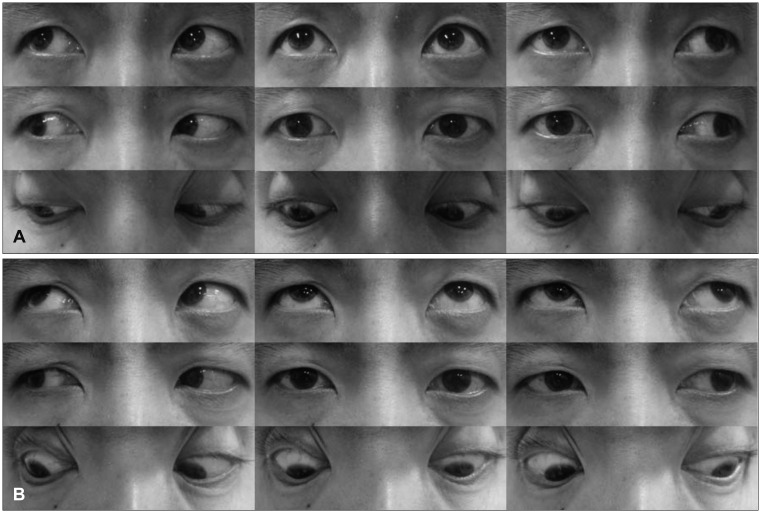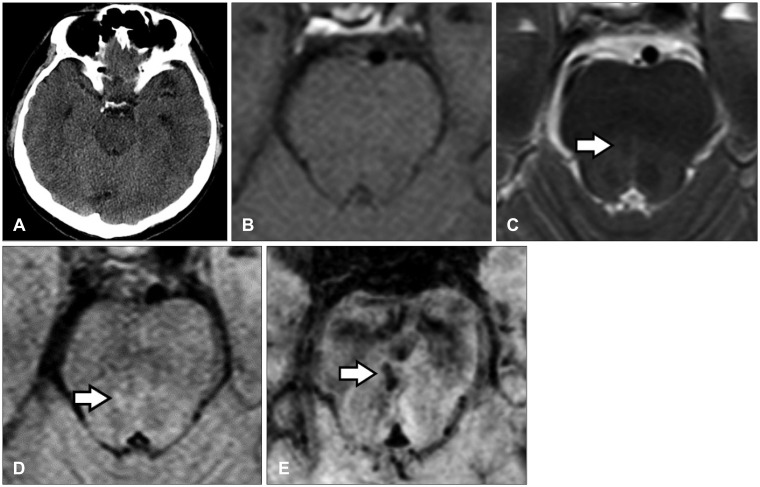Korean J Neurotrauma.
2016 Oct;12(2):140-143. 10.13004/kjnt.2016.12.2.140.
A Case of Traumatic Unilateral Internuclear Ophthalmoplegia: Clinical Significance of Susceptibility-Weighted Imaging
- Affiliations
-
- 1Department of Neurosurgery, College of Medicine, Chung-Ang University, Seoul, Korea. nsnam@cau.ac.kr
- KMID: 2356788
- DOI: http://doi.org/10.13004/kjnt.2016.12.2.140
Abstract
- A 43-year-old man was admitted for head trauma after falling backward. The patient complained of diplopia. Unilateral internuclear ophthalmoplegia (INO) was diagnosed during the neurologic examination. Initially, no specific finding was shown on T2-weighted, T1-weighted, and fluid attenuated inversion recovery brain magnetic resonance image (MRI) or brain computed tomography (CT). However, susceptibility-weighted imaging (SWI) definitively demonstrated a tiny hemorrhage at the midline of the pontomesencephalic junction. The patient's symptom improved after 12 weeks. We discuss the clinical significance of SWI when traumatic INO due to a tiny hemorrhage is suspected.
MeSH Terms
Figure
Reference
-
1. Akiyama Y, Miyata K, Harada K, Minamida Y, Nonaka T, Koyanagi I, et al. Susceptibility-weighted magnetic resonance imaging for the detection of cerebral microhemorrhage in patients with traumatic brain injury. Neurol Med Chir (Tokyo). 2009; 49:97–99. PMID: 19318732.
Article2. Baker RS. Internuclear ophthalmoplegia following head injury. Case report. J Neurosurg. 1979; 51:552–555. PMID: 479939.3. Beck RW, Meckler RJ. Internuclear ophthalmoplegia after head trauma. Ann Ophthalmol. 1981; 13:671–675. PMID: 7258960.4. Bradley WG Jr. MR appearance of hemorrhage in the brain. Radiology. 1993; 189:15–26. PMID: 8372185.
Article5. Chan JW. Isolated unilateral post-traumatic internuclear ophthalmoplegia. J Neuroophthalmol. 2001; 21:212–213. PMID: 11725189.
Article6. Constantoyannis C, Tzortzidis F, Papadakis N. Internuclear ophthalmoplegia following minor head injury: a case report. Br J Neurosurg. 1998; 12:377–379. PMID: 10070436.
Article7. Crompton MR. Brainstem lesions due to closed head injury. Lancet. 1971; 1:669–673. PMID: 4101614.8. Devereaux MW, Brust JC, Keane JR. Internuclear ophthalmoplegia caused by subdural hematoma. Neurology. 1979; 29:251–255. PMID: 571072.
Article9. Fiebach JB, Schellinger PD, Gass A, Kucinski T, Siebler M, Villringer A, et al. Stroke magnetic resonance imaging is accurate in hyperacute intracerebral hemorrhage: a multicenter study on the validity of stroke imaging. Stroke. 2004; 35:502–506. PMID: 14739410.10. Hardman JM. The pathology of traumatic brain injuries. Adv Neurol. 1979; 22:15–50. PMID: 384769.11. Hsu HC, Chen HJ, Lu K, Liang CL. Reversible bilateral internuclear ophthalmoplegia following head injury. Acta Ophthalmol Scand. 2001; 79:57–59. PMID: 11167289.
Article12. Johnson RT, Yates PO. Brain stem haemorrhages in expanding supratentorial conditions. Acta Radiol. 1956; 46:250–256. PMID: 13361934.
Article13. Jung DS, Park KP. Posttraumatic bilateral internuclear ophthalmoplegia with exotropia. Arch Neurol. 2004; 61:429. PMID: 15023822.
Article14. Keane JR. Traumatic internuclear ophthalmoplegia. J Clin Neuroophthalmol. 1987; 7:165–166. PMID: 2958510.15. Kim JS. Internuclear ophthalmoplegia as an isolated or predominant symptom of brainstem infarction. Neurology. 2004; 62:1491–1496. PMID: 15136670.
Article16. Liang L, Korogi Y, Sugahara T, Shigematsu Y, Okuda T, Ikushima I, et al. Detection of intracranial hemorrhage with susceptibility-weighted MR sequences. AJNR Am J Neuroradiol. 1999; 20:1527–1534. PMID: 10512241.17. Ogawa S, Lee TM, Kay AR, Tank DW. Brain magnetic resonance imaging with contrast dependent on blood oxygenation. Proc Natl Acad Sci U S A. 1990; 87:9868–9872. PMID: 2124706.
Article18. Schellinger PD, Jansen O, Fiebach JB, Hacke W, Sartor K. A standardized MRI stroke protocol: comparison with CT in hyperacute intracerebral hemorrhage. Stroke. 1999; 30:765–768. PMID: 10187876.
Article19. Strauss C, Ganslandt O, Huk WJ, Jonas JB. Isolated unilateral internuclear ophthalmoplegia following head injury: Findings in magnetic resonance imaging. Neuroophthalmology. 1995; 15:15–19.
Article
- Full Text Links
- Actions
-
Cited
- CITED
-
- Close
- Share
- Similar articles
-
- Traumatic Unilateral Tegmental Hematoma Representing Internuclear Ophthalmoplegia and Hornor's Syndrome: A Case Report
- Unilateral Internuclear Ophthalmoplegia Following Minor Head Injury
- A Case of Bilateral Internuclear Ophthalmoplegia
- MR imaging of internuclear ophthalmoplegia due to cerebrovascular diseases
- Unilateral Internuclear Ophthalmoplegia in a 14-year-old Female



